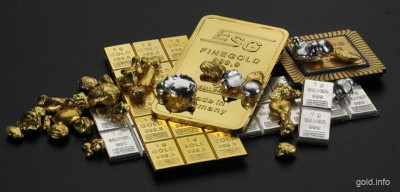Influence the Colour, Malleability and Melting Point of Gold
 Copper, silver and gold – they are dozing very nearby deep below the Earth’s surface and are often brought together for the production of gold alloys. Gold alloys are referred to as melted gold where other metals are added to the melt. The reason for this: To make gold easier to form into gold jewellery, this precious metal must fulfil certain characteristics. For example by adding zinc, tin or cadmium, the melting point and the surface tension are reduced, which means both a lower expenditure of energy during melting and an improved malleability are achieved. A further advantage of adding other metals to the melt: Gold is a very soft metal. The surface of a piece of jewellery made from pure gold is prone to unsightly scratches. By adding platinum or nickel the hardness of gold is increased. Every alloying of gold with other metals also reduces the special characteristics and quality of gold: the colour changes, the density drops and also the value of the precious metal is reduced. The goldsmith requires great sensitivity to achieve the best possible result from an alloy.
Copper, silver and gold – they are dozing very nearby deep below the Earth’s surface and are often brought together for the production of gold alloys. Gold alloys are referred to as melted gold where other metals are added to the melt. The reason for this: To make gold easier to form into gold jewellery, this precious metal must fulfil certain characteristics. For example by adding zinc, tin or cadmium, the melting point and the surface tension are reduced, which means both a lower expenditure of energy during melting and an improved malleability are achieved. A further advantage of adding other metals to the melt: Gold is a very soft metal. The surface of a piece of jewellery made from pure gold is prone to unsightly scratches. By adding platinum or nickel the hardness of gold is increased. Every alloying of gold with other metals also reduces the special characteristics and quality of gold: the colour changes, the density drops and also the value of the precious metal is reduced. The goldsmith requires great sensitivity to achieve the best possible result from an alloy.
The Difference Between the Value and Weight Proportions of Gold in Gold Alloys
The resulting changes in the gold characteristics due to the addition of other metals to the melt are always the impact of a modified atomic structure. More specifically, the numerical proportion of pure gold atoms to the total number of atoms in the alloy is altered. There must always be a differentiation between the pure numerical proportion and the proportion according to weight. Gold possesses an atomic mass number of 197, copper on the other hand has only 63 (around a third less weight). This means that with an identical atom-count of 1:1 (the same number of gold and copper atoms) gold has a much higher weight proportion – namely with 756 parts in 1000, which is about a 75% weight proportion. Factually however it only has a numerical proportion of 50% in the alloy. The value 333 for a gold alloy specifies on the one hand that a third of the weight of the alloy is gold. On the other hand however, the numerical proportion of gold atoms to the other metals is much less than a third. A low number of gold atoms is again at the expense of the material properties. 333 gold alloys flow very quickly, are not corrosion-resistant and do not exhibit a convincing colour. For this reason, these alloys are not officially termed gold.
Gold Alloys Fascinate with a Wide Colour Spectrum
The colour effect of a piece of gold jewellery on the purchaser is one of the most important beauty criteria when buying. Gold alloys enable a variety of colourings. Some metal additives impair the colour while on the other hand they give the alloy a special lustre or create other fine optical nuances. Whereas harder 585 gold alloys exhibit a rather pale colour, softer alloys with a gold weight proportion of at least a 75% have an intensive lustre. In the first instance a goldsmith selects an alloy according to the technology he wants to use when forming the gold and ultimately what the finished jewellery should look like. To achieve a compelling colour-effect, copper, silver, palladium or nickel are added in specific proportions. These metals lend their unique, very specific colour tones to the alloys, that create individual, interesting colour spectra in their respective combinations: beginning with a shimmering copper-coloured red gold via a rather silvery yellow gold to green, grey or white gold. There are a number of methods to produce a white gold alloy. To give the gold jewellery an exceptional white lustre, it is plated with a layer of rhodium. On the one hand the rhodium layer evokes a particular white lustre and furthermore makes the surface of the jewellery much harder.
Gold-Titanium Alloys – the Gold that is Made into Wedding Rings
The gold-titanium alloy is a special case. It is mostly used to manufacture wedding rings or also in medical technology. The all but pure gold is refined with one percent of titanium. The alloy is extraordinarily strong and shimmers nearly the same yellow as 750 gold. The added titanium also gives the alloy a fine, subtle grey tone.




